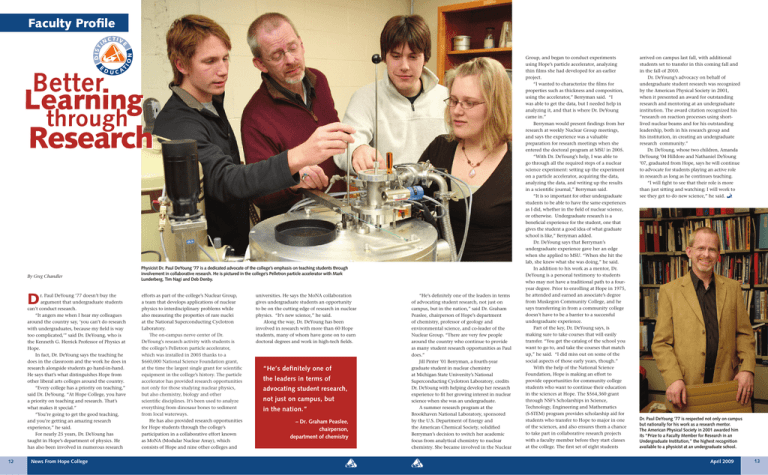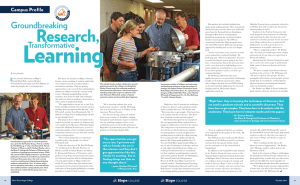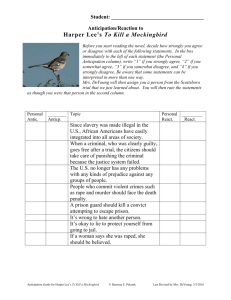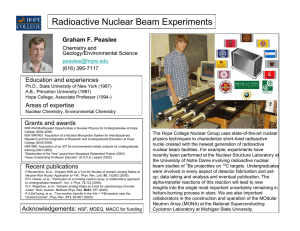D Faculty Profile
advertisement

Faculty Profile By Greg Chandler D r. Paul DeYoung ’77 doesn’t buy the argument that undergraduate students can’t conduct research. “It angers me when I hear my colleagues around the country say, ‘you can’t do research with undergraduates, because my field is way too complicated,’” said Dr. DeYoung, who is the Kenneth G. Herrick Professor of Physics at Hope. In fact, Dr. DeYoung says the teaching he does in the classroom and the work he does in research alongside students go hand-in-hand. He says that’s what distinguishes Hope from other liberal arts colleges around the country. “Every college has a priority on teaching,” said Dr. DeYoung. “At Hope College, you have a priority on teaching and research. That’s what makes it special.” “You’re going to get the good teaching, and you’re getting an amazing research experience,” he said. For nearly 25 years, Dr. DeYoung has taught in Hope’s department of physics. He has also been involved in numerous research 12 News From Hope College Physicist Dr. Paul DeYoung ’77 is a dedicated advocate of the college’s emphasis on teaching students through involvement in collaborative research. He is pictured in the college’s Pelletron particle accelerator with Mark Lunderberg, Tim Nagi and Deb Denby. efforts as part of the college’s Nuclear Group, a team that develops applications of nuclear physics to interdisciplinary problems while also measuring the properties of rare nuclei at the National Superconducting Cyclotron Laboratory. The on-campus nerve center of Dr. DeYoung’s research activity with students is the college’s Pelletron particle accelerator, which was installed in 2003 thanks to a $660,000 National Science Foundation grant, at the time the largest single grant for scientific equipment in the college’s history. The particle accelerator has provided research opportunities not only for those studying nuclear physics, but also chemistry, biology and other scientific disciplines. It’s been used to analyze everything from dinosaur bones to sediment from local waterways. He has also provided research opportunities for Hope students through the college’s participation in a collaborative effort known as MoNA (Modular Nuclear Array), which consists of Hope and nine other colleges and universities. He says the MoNA collaboration gives undergraduate students an opportunity to be on the cutting edge of research in nuclear physics. “It’s new science,” he said. Along the way, Dr. DeYoung has been involved in research with more than 60 Hope students, many of whom have gone on to earn doctoral degrees and work in high-tech fields. “He’s definitely one of the leaders in terms of advocating student research, not just on campus, but in the nation.” – Dr. Graham Peaslee, chairperson, department of chemistry “He’s definitely one of the leaders in terms of advocating student research, not just on campus, but in the nation,” said Dr. Graham Peaslee, chairperson of Hope’s department of chemistry, professor of geology and environmental science, and co-leader of the Nuclear Group. “There are very few people around the country who continue to provide as many student research opportunities as Paul does.” Jill Pinter ’01 Berryman, a fourth-year graduate student in nuclear chemistry at Michigan State University’s National Superconducting Cyclotron Laboratory, credits Dr. DeYoung with helping develop her research experience to fit her growing interest in nuclear science when she was an undergraduate. A summer research program at the Brookhaven National Laboratory, sponsored by the U.S. Department of Energy and the American Chemical Society, solidified Berryman’s decision to switch her academic focus from analytical chemistry to nuclear chemistry. She became involved in the Nuclear Group, and began to conduct experiments using Hope’s particle accelerator, analyzing thin films she had developed for an earlier project. “I wanted to characterize the films for properties such as thickness and composition, using the accelerator,” Berryman said. “I was able to get the data, but I needed help in analyzing it, and that is where Dr. DeYoung came in.” Berryman would present findings from her research at weekly Nuclear Group meetings, and says the experience was a valuable preparation for research meetings when she entered the doctoral program at MSU in 2005. “With Dr. DeYoung’s help, I was able to go through all the required steps of a nuclear science experiment: setting up the experiment on a particle accelerator, acquiring the data, analyzing the data, and writing up the results in a scientific journal,” Berryman said. “It is so important for other undergraduate students to be able to have the same experiences as I did, whether in the field of nuclear science, or otherwise. Undergraduate research is a beneficial experience for the student, one that gives the student a good idea of what graduate school is like,” Berryman added. Dr. DeYoung says that Berryman’s undergraduate experience gave her an edge when she applied to MSU. “When she hit the lab, she knew what she was doing,” he said. In addition to his work as a mentor, Dr. DeYoung is a personal testimony to students who may not have a traditional path to a fouryear degree. Prior to enrolling at Hope in 1975, he attended and earned an associate’s degree from Muskegon Community College, and he says transferring in from a community college doesn’t have to be a barrier to a successful undergraduate experience. Part of the key, Dr. DeYoung says, is making sure to take courses that will easily transfer. “You get the catalog of the school you want to go to, and take the courses that match up,” he said. “I did miss out on some of the social aspects of those early years, though.” With the help of the National Science Foundation, Hope is making an effort to provide opportunities for community college students who want to continue their education in the sciences at Hope. The $564,360 grant through NSF’s Scholarships in Science, Technology, Engineering and Mathematics (S-STEM) program provides scholarship aid for students who transfer to Hope to major in one of the sciences, and also ensures them a chance to take part in collaborative research projects with a faculty member before they start classes at the college. The first set of eight students arrived on campus last fall, with additional students set to transfer in this coming fall and in the fall of 2010. Dr. DeYoung’s advocacy on behalf of undergraduate student research was recognized by the American Physical Society in 2001, when it presented an award for outstanding research and mentoring at an undergraduate institution. The award citation recognized his “research on reaction processes using shortlived nuclear beams and for his outstanding leadership, both in his research group and his institution, in creating an undergraduate research community.” Dr. DeYoung, whose two children, Amanda DeYoung ’04 Hilldore and Nathaniel DeYoung ’07, graduated from Hope, says he will continue to advocate for students playing an active role in research as long as he continues teaching. “I will fight to see that their role is more than just sitting and watching; I will work to see they get to do new science,” he said. Dr. Paul DeYoung ’77 is respected not only on campus but nationally for his work as a research mentor. The American Physical Society in 2001 awarded him its “Prize to a Faculty Member for Research in an Undergraduate Institution,” the highest recognition available to a physicist at an undergraduate school. April 2009 13





